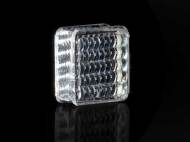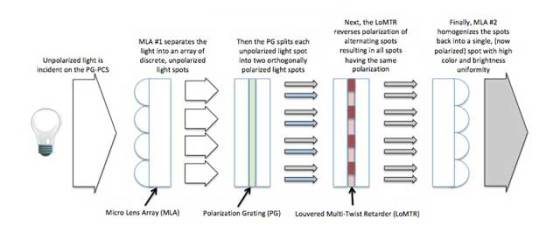New technology improves light polarization in LC projectors
 Researchers from North Carolina State University and ImagineOptix Corporation have developed new technology which provides a major breakthrough for projectors that use liquid crystal (LC) technology. The new technology could lead to projectors which are smaller, nearly two times more efficient and more affordable, thus enabling their longer battery life and significantly lower levels of heat they tend to have.
Researchers from North Carolina State University and ImagineOptix Corporation have developed new technology which provides a major breakthrough for projectors that use liquid crystal (LC) technology. The new technology could lead to projectors which are smaller, nearly two times more efficient and more affordable, thus enabling their longer battery life and significantly lower levels of heat they tend to have.
LC projectors, which are becoming more commonly used in classrooms and conference rooms, use polarized light to project images. The technology uses efficient light sources, such as light-emitting diodes (LEDs), which naturally produce unpolarized light. The most common method to convert unpolarized light into polarized light is achieved with usage of polarizing filters. However, these filters waste more than half of the originally generated light, with the majority of the “lost” light being turned into heat.
In order to counter this problem, the ImagineOptix-sponsored research team from NC State developed new polarizing technology which allows approximately 90% of the unpolarized light to be polarized. Named polarization grating-polarization conversion system (PGPCS), the technology significantly improves the energy efficiency of LC projectors.
The technology is a small single-unit assembly composed of four fixed parts. A beam of unpolarized light first passes through an array of lenses, which focus the light into a grid of spots. The light then passes through a polarization grating, which consists of a thin layer of liquid crystal material on a glass plate. The polarization grating separates the spots of light into pairs, which have opposite polarizations. The light then passes through a louvered wave plate, which is a collection of clear, patterned plates that gives the beams of light the same polarization. Finally, a second array of lenses focuses the spots of light back into a single, uniform beam of light.
Because only 10 percent of the unpolarized light is converted into heat, the new technology will also reduce the need for loud cooling fans and enable more compact designs. The NC State technology was used by ImagineOptix to create a small picoprojector whose improved versions could be used in devices such as smartphones or tablets.
“The commercial implications are broad reaching. Projectors that rely on batteries will be able to run for almost twice as long. And LC projectors of all kinds can be made twice as bright but use the same amount of power that they do now. However, we can’t promise that this will make classes and meetings twice as exciting”, said Dr. Michael Escuti, associate professor of electrical and computer engineering at NC State.
For more information, read the paper published in Applied Optics: “Efficient and monolithic polarization conversion system based on a polarization grating”.










Leave your response!